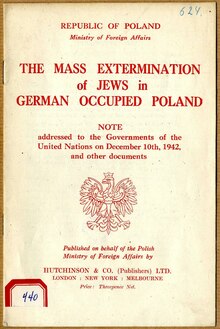The history of Poland from 1939 to 1945 encompasses primarily the period from the invasion of Poland by Nazi Germany and the Soviet Union to the end of World War II. Following the German–Soviet non-aggression pact, Poland was invaded by Nazi Germany on 1 September 1939 and by the Soviet Union on 17 September. The campaigns ended in early October with Germany and the Soviet Union dividing and annexing the whole of Poland. After the Axis attack on the Soviet Union in the summer of 1941, the entirety of Poland was occupied by Germany, which proceeded to advance its racial and genocidal policies across Poland.
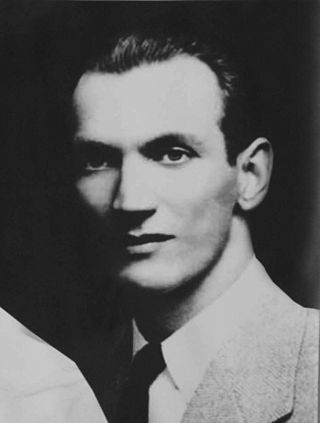
Jan Karski was a Polish soldier, resistance-fighter, and diplomat during World War II. He is known for having acted as a courier in 1940–1943 to the Polish government-in-exile and to Poland's Western Allies about the situation in German-occupied Poland. He reported about the state of Poland, its many competing resistance factions, and also about Germany's destruction of the Warsaw Ghetto and its operation of extermination camps on Polish soil that were murdering Jews, Poles, and others.

Żegota was the Polish Council to Aid Jews with the Government Delegation for Poland, an underground Polish resistance organization, and part of the Polish Underground State, active 1942–45 in German-occupied Poland. Żegota was the successor institution to the Provisional Committee to Aid Jews and was established specifically to save Jews. Poland was the only country in German-occupied Europe where such a government-established and -supported underground organization existed.
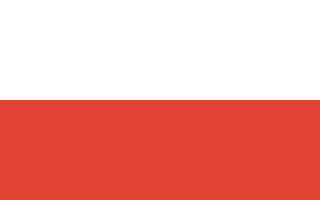
The Polish government-in-exile, officially known as the Government of the Republic of Poland in exile, was the government in exile of Poland formed in the aftermath of the Invasion of Poland of September 1939, and the subsequent occupation of Poland by Germany, the Soviet Union, and the Slovak Republic, which brought to an end the Second Polish Republic.
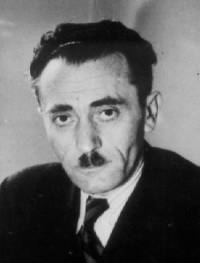
Szmul Mordko Zygielbojm was a Polish socialist politician, Bund trade-union activist, and member of the National Council of the Polish government-in-exile.

Count Edward Bernard Raczyński was a Polish diplomat, writer, politician, President of Poland-in-exile.
In the decades since the Holocaust, some national governments, international bodies and world leaders have been criticized for their failure to take appropriate action to save the millions of European Jews, Roma, and other victims of the Holocaust. Critics say that such intervention, particularly by the Allied governments, might have saved substantial numbers of people and could have been accomplished without the diversion of significant resources from the war effort.

In Poland, the resistance movement during World War II was led by the Home Army. The Polish resistance is notable among others for disrupting German supply lines to the Eastern Front, and providing intelligence reports to the British intelligence agencies. It was a part of the Polish Underground State.

The Auschwitz Protocols, also known as the Auschwitz Reports, and originally published as The Extermination Camps of Auschwitz and Birkenau, is a collection of three eyewitness accounts from 1943–1944 about the mass murder that was taking place inside the Auschwitz concentration camp in German-occupied Poland during the Second World War. The eyewitness accounts are individually known as the Vrba–Wetzler report, Polish Major's report, and Rosin-Mordowicz report.

The Holocaust in Poland was the ghettoization, robbery, deportation, and murder of Jews, simultaneously with other people groups for identical racial pretexts, in occupied Poland, organized by Nazi Germany. Three million Polish Jews were murdered, primarily at the Chelmno, Belzec, Sobibor, Treblinka, and Auschwitz II–Birkenau extermination camps, representing half of all Jews murdered during the Europe-wide Holocaust.

The issue of why the Allies did not act on early reports of atrocities in the Auschwitz concentration camp by destroying it or its railways by air during World War II has been a subject of controversy since the late 1970s. Brought to public attention by a 1978 article from historian David Wyman, it has been described by Michael Berenbaum as "a moral question emblematic of the Allied response to the plight of the Jews during the Holocaust", and whether or not the Allies had the requisite knowledge and the technical capability to act continues to be explored by historians. The U.S. government followed the military's strong advice to always keep the defeat of Germany the paramount objective, and refused to tolerate outside civilian advice regarding alternative military operations. No major American Jewish organizations recommended bombing.

Polish Jews were the primary victims of the Nazi Germany-organized Holocaust in Poland. Throughout the German occupation of Poland, Jews were rescued from the Holocaust by Polish people, at risk to their lives and the lives of their families. According to Yad Vashem, Israel's official memorial to the victims of the Holocaust, Poles were, by nationality, the most numerous persons identified as rescuing Jews during the Holocaust. By January 2022, 7,232 people in Poland have been recognized by the State of Israel as Righteous among the Nations.
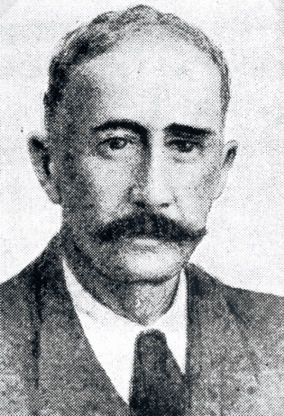
Leon Feiner was a Polish lawyer and activist. He was an activist of the General Jewish Labour Bund in Poland and between November 1944 and January 1945 the director (prezes) and vice-chairman of the Council to Aid Jews "Żegota".

The occupation of Poland by Nazi Germany and the Soviet Union during World War II (1939–1945) began with the Invasion of Poland in September 1939, and it was formally concluded with the defeat of Germany by the Allies in May 1945. Throughout the entire course of the occupation, the territory of Poland was divided between Nazi Germany and the Soviet Union (USSR), both of which intended to eradicate Poland's culture and subjugate its people. In the summer-autumn of 1941, the lands which were annexed by the Soviets were overrun by Germany in the course of the initially successful German attack on the USSR. After a few years of fighting, the Red Army drove the German forces out of the USSR and crossed into Poland from the rest of Central and Eastern Europe.

During the Holocaust in Poland, 1939–1945, German occupation authorities engaged in repressive measures against non-Jewish Polish citizens who helped Jews persecuted by Nazi Germany.
During the German occupation of Poland, citizens of all its major ethnic groups collaborated with the Germans. Estimates of the number of collaborators vary. Collaboration in Poland was less institutionalized than in some other countries and has been described as marginal, a point of pride with the Polish people. During and after the war, the Polish government in exile and the Polish resistance movement punished collaborators and sentenced thousands of them to death.
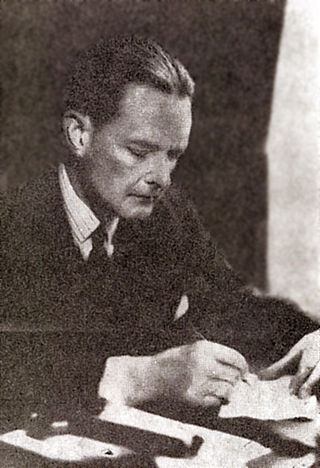
Raczyński's Note, dated December 10, 1942, and signed by Minister of Foreign Affairs Edward Raczyński, was the official diplomatic note from the government of Poland in exile regarding the extermination of the Jews in German-occupied Poland. Sent to the foreign ministers of the Allies, it was the first official report on the Holocaust to inform the Western public about these crimes. It identified Treblinka, Bełżec and Sobibór by name as extermination camps. It was also the first official speech of one of the governments of Nazi-occupied Europe in defense of all Jews persecuted by Germany – not only citizens of their country.

Protest! was a clandestine leaflet issued in 1942 as a protest by Polish Catholics against the mass murder of Jews in German-occupied Poland.
Karski's reports were a series of reports attributed to Jan Karski, an investigator working for the Polish government-in-exile during World War II, describing the situation in occupied Poland. They were some of the first documents on the Holocaust in Poland received by the Polish government in exile, and, through it, by the Western Allies.
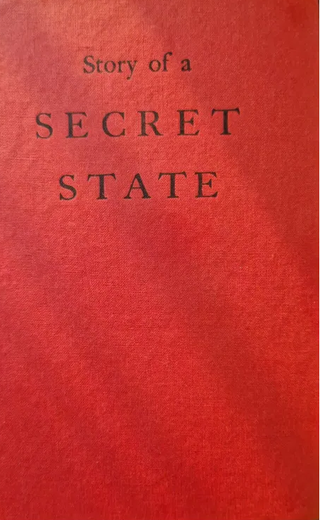
Story of a Secret State is a 1944 book by Polish resistance Home Army courier Jan Karski. First published in the United States in 1944, it narrates Karski's experiences with the Polish Resistance, and it is also one of the first book accounts of the German occupation of Poland, including the Holocaust in Poland.
